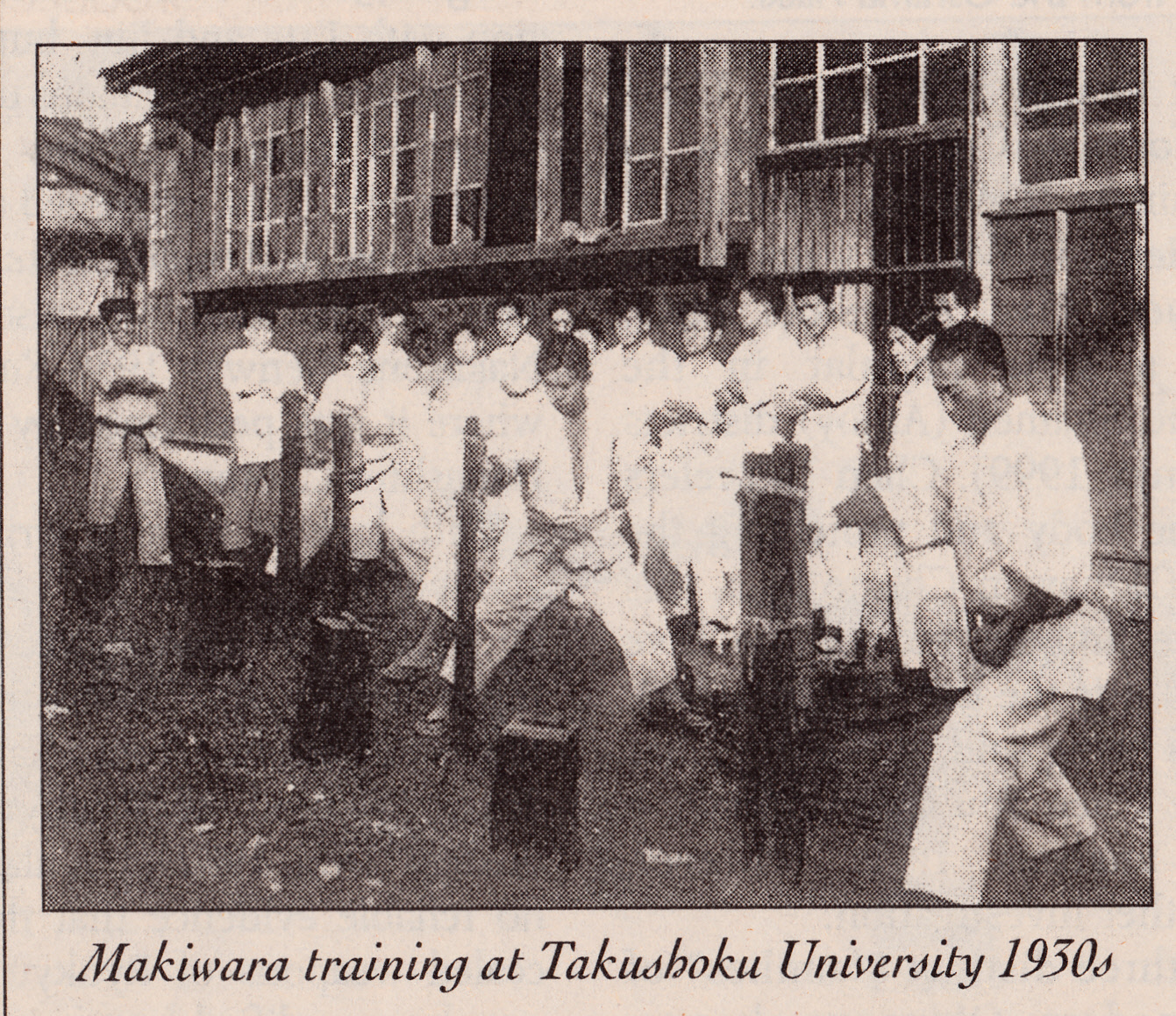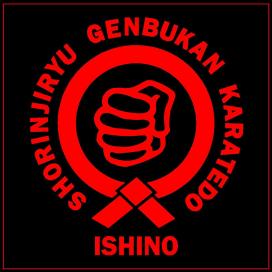This article will be about the Makiwara as we use it in Shorinjiryu Genbukan Karatedo.

Outdoor makiwara image from the book, Zukai setsumei goshinjutsu, kobudo kenpo karate katsuyo, 1952.
What is a Makiwara?
The Japanese word, Makiwara (巻藁): Maki means “to roll up” or “coil” (a recognizable term for any sushi lover), while Wara translates to “straw.” The traditional karate striking post was a board wrapped with a straw coil on one end and buried in the ground at the other, is thought to be uniquely Okinawan in origin. The makiwara is used by karate practitioners to practice strikes, somewhat similar to how western boxers, Muay Thai fighters and Mixed Martial Arts (MMA) fighters would use the heavy bag.

How to Build Your Own Old-school Outdoor Makiwara
Traditionally, the makiwara is installed by burying it in the ground. This requires digging a hole that is at least 3 feet (90cm) deep. Depending on the soil where you live, this can be quite difficult.
Materials for the Post:
- A post hole-digger and or shovel;
- Loose gravel and rocks to fill the bottom of your hole about 2-3” (5-7cm) high (To help drain water from accumulating at the bottom of the post);
- Two 18” (46cm) long pieces from a 4”x2” lumber (These will be your cross braces, and will stabilize the buried section of the makiwara);
- 3″ long wood screws or nails (Use about 4 on each to attach the cross braces to the makiwara post);
- Screwdriver or electric drill with appropriate screwdriver bit;
- Measuring Square (to ensure post is perpendicular once secured into the ground);
- Wood preservative (Apply to the length of the makiwara that is buried);
- Wood deck sealer (Apply to top and bottom ends of the makiwara to weatherproof);
- One 8 ft (244 cm) long and 4” x 4” lumber post (4” x 4” lumber is actually only 3.5” wide)
For the post, select wood that is as knot free as possible, and in which the grains of the wood run parallel to the length of the post. Almost any good quality construction lumber will do.
- Ash is a hardwood and is denser and stiffer than redwood so is able to withstand regular heavy training. Ash is used to make baseball bats and pick axe handles and when cut with a taper, ash offers some flexibility as ash is the stiffest post. The material used in this post will last for years of regular use, even in exposed sites.
- White Oak is a dense heavy wood but still allows good flexibility. Oak is more flexible than ash posts but no less durable. The material used in this post will last for years of regular use, even in exposed sites.
NOTE. I personally do not recommend using pressure treated lumber for the construction of your makiwara. This type of wood is saturated with chemicals to protect the wood from insects. Since you will be constantly touching the makiwara, you are constantly touching wood that is impregnated with poisonous chemicals. Feel free to agree to disagree. My preference is not to.
How tall your makiwara will be depends on you the user. It is usually set to a height above ground that results in the top of the makiwara lining up with the height of your shoulder or your solar plexus when standing up. You can make your makiwara taller or shorter than that. It is your makiwara. Mark that height on the post for the ground-surface line and allow between 3 to 4 feet to be buried. Cut off any extra so you won’t have to dig deeper then you need to.
At the top of the post, make your makiwara between ½” to ¾” (1.3 – 1.9cm) thick. The tapered shape of the makiwara post is very important, as it this shape that gives it progressive resistance. You can pay the lumber store to cut it for you and have two makiwara posts; one for now, one for later.
Apply the Wood deck sealer to the ends of the post and the Wood preservative to the length of the makiwara that is to buried, going up the makiwara post about 12” (30cm) above the ground surface line.
First be sure to contact your local utilities company to find out if there are any water pipes or other utility lines buried beneath the earth where you’re planning to dig. You want to be sure you are clear of any potential hazards.
Get your post hole-digger and or shovel and dig a hole 3-4 feet deep depending on the length you measured for the buried length of the makiwara post and slightly wider than 18 inches to allow for the cross braces.
Pack the hole for the makiwara with gravel and rocks,
Attach your two 18 inch wide cross braces to the makiwara post approximately 8 inches and 30 inches from the end that will be buried in the ground. I used 4 screws on each cross brace to fasten them to the post.
It’s important that the cross brace closest to the bottom is attached on the “front” side of the makiwara, while the other cross brace closest to the ground-surface line is attached on the “back” side. This provides maximum resistance to the force applied when struck.
Insert the post into the hole and ensure the top cross brace is at least 6 inches below the surface of the earth. Fill hole around post with the soil you removed when digging the hole. Use your Measuring Square to check perpendicular and compact the earth around the base as you secure the post in place.
Materials for the Striking Part of the Makiwara:
The head of the makiwara can be made from anything that provides a cushion for you to strike.
You could wrap the head will a towel and tape it securely or you might like to make one of straw, rope and canvas in the traditional way..
How to use the Makiwara.
The makiwara is very versatile, and can accommodate practice of open/closed hand strikes, kicks, knee strikes and elbow strikes. Okinawan methods emphasize striking from different angles. Most sources recommend a regimen of hitting the makiwara 50–100 times per day, with each hand. It is especially important to train the weaker side of the body as hard as, or harder than the dominant side.
The very first thing to remember when practising with a makiwara is that it will always win. If you punch it too hard, too soon, you will damage a knuckle … makiwara wins.
When starting, just push the pad with your punch, being wary to get all the little details correct such as:
– First two knuckles of the fist contact the pad;
– Strong wrist;
– Arm extended but elbow not locked;
– Shoulders down;
– Head up;
– Rear hand well chambered;
– Hip rotation into the punch;
– Strong stance;
– Muscles not used in the techniques very relaxed;
– Mind focusing on refining the technique, not other distractions.
What’s important is not how hard it’s hit, but how many times. With more practice you can increase the power.
Why do some people consider the makiwara dangerous?
It is important to not use the makiwara to the point that it causes them harm. Like all good training, there should be no lasting damage.
There have been plenty of reports of people damaging their hands and feet from using the makiwara. It should be noted that long-term use of the makiwara has been reported to lead to calloused knuckles and in some cases, more severe injuries.
However, like everything else, if you take time to learn how to strike in the correct way from a qualified and experienced instructor, the risk of damage to yourself should be minimal.

“The most popular way of training with the seiken is to make use of a makiwara, a thick post covered with rice straw. The makiwara also, incidentally, may be used in strengthening the sword hand (shutō), the elbows and the knees. I think I am in no way exaggerating when I say that practice with the makiwara is the keystone in the creation of strong weapons.”
Gichin Funakoshi
Karate-Dō My way of life

This outdoor makiwara was made with Manila rope available from Home Depot !
